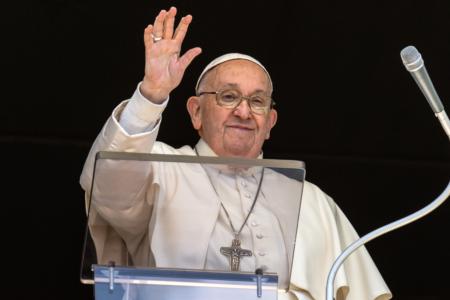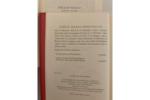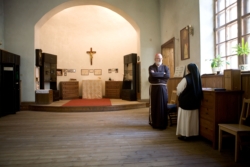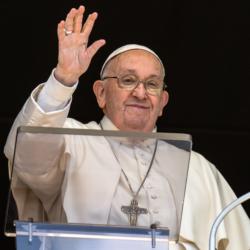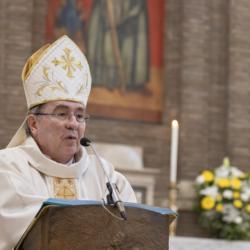From Cardinal Seán’s blog
[Cardinal Seán O’Malley and Boston’s Greek Orthodox Metropolitan Methodios recently led a joint Catholic-Orthodox pilgrimage to Rome, Istanbul and St. Petersburg, Russia. The group set out from Boston Sept. 16 and returned Sept. 26. For coverage of the Rome and Istanbul legs of the pilgrimage, see The Pilot issues of Sept. 21 and 28, respectively or visit www.TheBostonPilot.com.]
From Turkey we flew to St. Petersburg, Russia, where we spent two days. There, we visited three magnificent Orthodox churches -- two of which have been turned into museums.
The Kazan Cathedral is the cathedral for the Russian Orthodox and is still functioning as a church. The three churches were built by the czars and have been restored. They are gorgeous with mosaics, gold and artwork that is comparable to anything you would see in Rome. They were just fantastic.
Peter the Great, who founded St. Petersburg, wanted to make it a very European city. He brought architects and artists from Italy and France to design the churches, and they look very much like Roman Catholic churches.
The exception to that is the Church of the Spilt Blood, which was built over the place where one of the czars was assassinated. That is a very Russian looking church with the onion domes.
We visited St. Isaac Cathedral, which is now a museum. Many of the churches in Russia were converted to museums or given over for completely secular uses under the communist government. Many of those church buildings are being returned to the churches. The Catholic Church has recovered some buildings.
We did have a visit to the Hermitage Museum, which is one of the best museums of the world and very much built by Catherine the Great. They have an incredible collection of art, much of it religious, including beautiful sculptures of the Madonna by Da Vinci and Rafael. The famous Rembrandt of the Prodigal Son is also located there as well as many other magnificent works of art.
I did not spend too much time in the Hermitage [Museum] because the metropolitan and I went for a very interesting meeting with the Russian metropolitan. The meeting took place at the Alexander Nevsky Monastery of the Holy Trinity. Near the monastery is the Tikhvin Cemetery where Fyodor Dostoevsky, Peter Tchaikovsky and many other famous Russian artists are buried.
During the communist period, the monastery was used for atomic research. It has only recently been restored to the Russian Church. They have had hundreds of churches turned back to them, and they are trying to restore them and train catechists. The metropolitan there, Vladimir, is 78 years old. He had been an observer at the Second Vatican Council and knew Blessed John XXIII.
Metropolitan Vladimir is a man who really is interested in church unity. He was very, very gracious to us and gave us a beautiful book about his monastery. They have a Russian seminary there with 500 students. We went to visit and had lunch there. In conjunction with the seminary, they have a school to train iconographers and musicians, the three main elements so important in the Orthodox liturgy.
That was to me a great joy to be able to meet him. He told us that over 100,000 Orthodox had died for the faith during the Communist persecution. He now has about 500 priests in his diocese.
On Tuesday, the last day of our visit, we had Mass at St. Catherine Church, the Roman Catholic Church there. It is a beautiful church and one of five Catholic churches in St. Petersburg, home to 5,000 Catholics. The city is part of the Diocese of Moscow, which is quite far away.
St. Catherine’s was once used as a motorcycle repair shop, but has been restored and is now run by the Dominican friars who are mostly from Poland. Many of the Catholics in St. Petersburg are of Polish descent -- the grandchildren of Polish immigrants.
Sister Maria Sulapa, a Dominican nun who is the sacristan at St. Catherine’s was very lovely. She is from Honduras and came to Russia 12 years ago.
After our visit to St. Petersburg, we flew back to Boston arriving at Logan airport on Thursday evening.
It was a privilege to be a part of this pilgrimage. I am overwhelmed by the thought that perhaps our modest efforts are a witness to the importance of working for unity between the Catholic and Orthodox Churches. Certainly, the spirit of prayer as we went back and forth to each others’ services was very beautiful. However, at the same time, there was the pain of not being able to receive Communion at each others services’ even though we believe in the validity of their orders.
Hopefully our efforts have promoted understanding between our two Churches. I was very glad to spend time with the people who came with the Greek Orthodox Church in Boston. Metropolitan Methodios is always so gracious and his priests and people were a joy to be with. I think for all the Catholics it was a very good experience as well.
